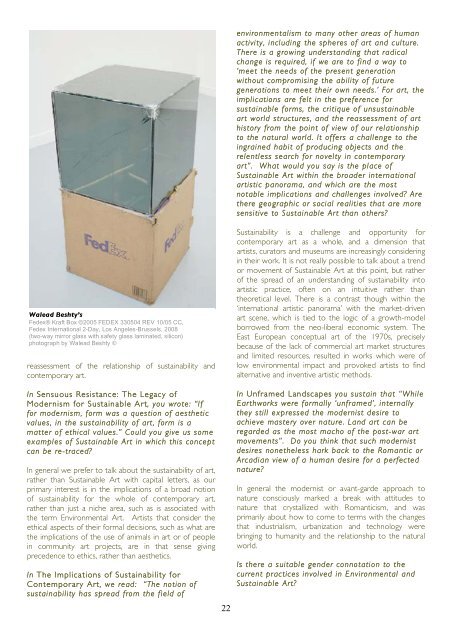M - Antennae The Journal of Nature in Visual Culture
M - Antennae The Journal of Nature in Visual Culture
M - Antennae The Journal of Nature in Visual Culture
You also want an ePaper? Increase the reach of your titles
YUMPU automatically turns print PDFs into web optimized ePapers that Google loves.
Walead Beshty’s<br />
Fedex® Kraft Box ©2005 FEDEX 330504 REV 10/05 CC,<br />
Fedex International 2-Day, Los Angeles-Brussels, 2008<br />
(two-way mirror glass with safety glass lam<strong>in</strong>ated, silicon)<br />
photograph by Walead Beshty �<br />
reassessment <strong>of</strong> the relationship <strong>of</strong> susta<strong>in</strong>ability and<br />
contemporary art.<br />
In Sensuous Resistance: <strong>The</strong> Legacy <strong>of</strong><br />
Modernism for Susta<strong>in</strong>able Art, you wrote: “If<br />
for modernism, form was a question <strong>of</strong> aesthetic<br />
values, <strong>in</strong> the susta<strong>in</strong>ability <strong>of</strong> art, form is a<br />
matter <strong>of</strong> ethical values.” Could you give us some<br />
examples <strong>of</strong> Susta<strong>in</strong>able Art <strong>in</strong> which this concept<br />
can be re-traced?<br />
In general we prefer to talk about the susta<strong>in</strong>ability <strong>of</strong> art,<br />
rather than Susta<strong>in</strong>able Art with capital letters, as our<br />
primary <strong>in</strong>terest is <strong>in</strong> the implications <strong>of</strong> a broad notion<br />
<strong>of</strong> susta<strong>in</strong>ability for the whole <strong>of</strong> contemporary art,<br />
rather than just a niche area, such as is associated with<br />
the term Environmental Art. Artists that consider the<br />
ethical aspects <strong>of</strong> their formal decisions, such as what are<br />
the implications <strong>of</strong> the use <strong>of</strong> animals <strong>in</strong> art or <strong>of</strong> people<br />
<strong>in</strong> community art projects, are <strong>in</strong> that sense giv<strong>in</strong>g<br />
precedence to ethics, rather than aesthetics.<br />
In <strong>The</strong> Implications <strong>of</strong> Susta<strong>in</strong>ability for<br />
Contemporary Art, we read: “<strong>The</strong> notion <strong>of</strong><br />
susta<strong>in</strong>ability has spread from the field <strong>of</strong><br />
22<br />
environmentalism to many other areas <strong>of</strong> human<br />
activity, <strong>in</strong>clud<strong>in</strong>g the spheres <strong>of</strong> art and culture.<br />
<strong>The</strong>re is a grow<strong>in</strong>g understand<strong>in</strong>g that radical<br />
change is required, if we are to f<strong>in</strong>d a way to<br />
‘meet the needs <strong>of</strong> the present generation<br />
without compromis<strong>in</strong>g the ability <strong>of</strong> future<br />
generations to meet their own needs.’ For art, the<br />
implications are felt <strong>in</strong> the preference for<br />
susta<strong>in</strong>able forms, the critique <strong>of</strong> unsusta<strong>in</strong>able<br />
art world structures, and the reassessment <strong>of</strong> art<br />
history from the po<strong>in</strong>t <strong>of</strong> view <strong>of</strong> our relationship<br />
to the natural world. It <strong>of</strong>fers a challenge to the<br />
<strong>in</strong>gra<strong>in</strong>ed habit <strong>of</strong> produc<strong>in</strong>g objects and the<br />
relentless search for novelty <strong>in</strong> contemporary<br />
art”. What would you say is the place <strong>of</strong><br />
Susta<strong>in</strong>able Art with<strong>in</strong> the broader <strong>in</strong>ternational<br />
artistic panorama, and which are the most<br />
notable implications and challenges <strong>in</strong>volved? Are<br />
there geographic or social realities that are more<br />
sensitive to Susta<strong>in</strong>able Art than others?<br />
Susta<strong>in</strong>ability is a challenge and opportunity for<br />
contemporary art as a whole, and a dimension that<br />
artists, curators and museums are <strong>in</strong>creas<strong>in</strong>gly consider<strong>in</strong>g<br />
<strong>in</strong> their work. It is not really possible to talk about a trend<br />
or movement <strong>of</strong> Susta<strong>in</strong>able Art at this po<strong>in</strong>t, but rather<br />
<strong>of</strong> the spread <strong>of</strong> an understand<strong>in</strong>g <strong>of</strong> susta<strong>in</strong>ability <strong>in</strong>to<br />
artistic practice, <strong>of</strong>ten on an <strong>in</strong>tuitive rather than<br />
theoretical level. <strong>The</strong>re is a contrast though with<strong>in</strong> the<br />
‘<strong>in</strong>ternational artistic panorama’ with the market-driven<br />
art scene, which is tied to the logic <strong>of</strong> a growth-model<br />
borrowed from the neo-liberal economic system. <strong>The</strong><br />
East European conceptual art <strong>of</strong> the 1970s, precisely<br />
because <strong>of</strong> the lack <strong>of</strong> commercial art market structures<br />
and limited resources, resulted <strong>in</strong> works which were <strong>of</strong><br />
low environmental impact and provoked artists to f<strong>in</strong>d<br />
alternative and <strong>in</strong>ventive artistic methods.<br />
In Unframed Landscapes you susta<strong>in</strong> that “While<br />
Earthworks were formally ‘unframed’, <strong>in</strong>ternally<br />
they still expressed the modernist desire to<br />
achieve mastery over nature. Land art can be<br />
regarded as the most macho <strong>of</strong> the post-war art<br />
movements”. Do you th<strong>in</strong>k that such modernist<br />
desires nonetheless hark back to the Romantic or<br />
Arcadian view <strong>of</strong> a human desire for a perfected<br />
nature?<br />
In general the modernist or avant-garde approach to<br />
nature consciously marked a break with attitudes to<br />
nature that crystallized with Romanticism, and was<br />
primarily about how to come to terms with the changes<br />
that <strong>in</strong>dustrialism, urbanization and technology were<br />
br<strong>in</strong>g<strong>in</strong>g to humanity and the relationship to the natural<br />
world.<br />
Is there a suitable gender connotation to the<br />
current practices <strong>in</strong>volved <strong>in</strong> Environmental and<br />
Susta<strong>in</strong>able Art?












